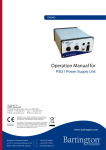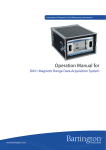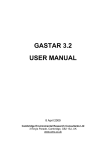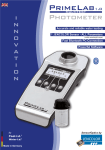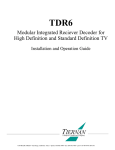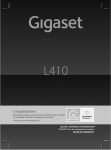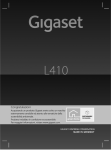Download Bartington PSU1 Specifications
Transcript
OM2240 Operation Manual for Mag639 Three-Axis Fluxgate Magnetometer Specifications may be subject to slight alteration without prior notice. This system is not qualified for use in explosive atmospheres or life support systems. Consult Bartington Instruments for advice. The copyright of this document is the property of Bartington Instruments Ltd. The document is supplied on the condition that it is to be treated commercially confidential and it may not therefore be disclosed to any third party without written authorisation of the Managing Directors of Bartington instruments Bartington Instruments Limited T: +44 (0)1993 706565 5, 10 & 11 Thorney Leys Business Park F: +44 (0)1993 774813 Witney, Oxford, OX28 4GE, England. E: [email protected] www.bartington.com BARTINGTON INSTRUMENTS Table of Contents Table of Contents ................................................................................. 1 How to use this Manual........................................................................ 3 Symbols Glossary .......................................................................... 3 Waste Electrical and Electronic Equipment (WEEE) Regulations ......... 3 Introduction to the Mag639 ................................................................. 4 Vector Measurements and Conventions ...................................... 4 Installing the Mag639 ........................................................................... 5 Siting the Magnetometer (Environment Recommendations) ...... 5 Connection Recommendations .................................................... 5 Connector pin allocation............................................. 5 Interface...................................................................... 5 Power supplies ............................................................ 5 Pre-Installation Tests .................................................................... 6 Mounting Recommendations ....................................................... 6 Post Installation Testing................................................................ 6 Using the Mag639 ................................................................................ 7 Cabling .......................................................................................... 7 Connecting Power......................................................................... 7 Response ....................................................................................... 7 Electromagnetic Compatibility ..................................................... 7 Performance ................................................................................. 8 Signal Processing......................................................... 8 Magnetic Hysteresis...................................................................... 8 Environmental Precautions .......................................................... 8 Troubleshooting ................................................................................... 9 Care and Maintenance ....................................................................... 10 Cleaning the Mag639 .................................................................. 10 Page 1 of 12 M2240 ISSUE 1 BARTINGTON INSTRUMENTS Calibration................................................................................... 10 End of Life Disposal............................................................................. 10 Accessories ......................................................................................... 11 PSU1 and Magmeter Power Supply Units .................................. 11 Spectramag-6 Data Acquisition System ...................................... 11 SCU1 Signal Conditioning Unit .................................................... 11 Appendix 1 .......................................................................................... 12 Use of Alternative Power supplies .............................................. 12 Signal/power ground .................................................................. 12 Page 2 of 12 M2240 ISSUE 1 BARTINGTON INSTRUMENTS How to use this Manual This document describes the installation, operation and maintenance of Mag639 Magnetic Field Sensor. Take the time to get well acquainted with your purchase by reading this manual. Knowing and understanding your sensor will ensure you experience the most reliable operation. When service or maintenance is required, contact the Bartington Instruments service team*. Technical specifications for this product can be found in the appropriate datasheets. Details can be found on the Bartington Instruments website. Visit the Bartington website regularly for more information about any changes to our product range, and for software downloads, datasheets and support details. You can access all the information you need about your specific sensor, including service information, at www.bartington.com. * To discuss solutions and repair procedures email: [email protected] or telephone the Bartington Instruments service team on +44 (0) 1993 706565. Symbols Glossary The following symbols used within this manual call your attention to specific types of information: WARNING: Indicates a situation in which serious bodily injury or death could result if the warning is ignored. Caution: Indicates a situation in which bodily injury or damage to your instrument, or both, could result if the caution is ignored. This symbol identifies items that must be disposed of safely to prevent unnecessary damage to the environment. Note: A note provides useful supporting information and sometimes suggests how to make better use of your purchase. Waste Electrical and Electronic Equipment (WEEE) Regulations The Mag639 complies fully with Reduction of Hazardous Substances (RoHS) legislation current at the time of printing. However, electronic equipment should never be disposed of in normal waste. For information about disposing of your magnetometer safely refer to the section on End of Life Disposal. Page 3 of 12 M2240 ISSUE 1 BARTINGTON INSTRUMENTS Introduction to the Mag639 The Mag639 is a magnetometer consisting of a cluster of three, feedback stabilised, fluxgate sensors arranged along X, Y and Z axes. Each axis provides a highly linear magnetic response with low hysteresis and low cross talk between axes. Mag639 is ideal for use in electromagnetic (EM) survey systems (e.g. TDEM and MT) where its extra frequency response can increase overall system sensitivity. The standard Mag639 has a pre-fitted circular connector on a 2.5m lead. A mating connector is supplied for the customer to connect to their own equipment Vector Measurements and Conventions The magnetometer produces three independent analog output voltages in response to the magnitude and direction of the orthogonal components of a magnetic field. A "right-hand" co-ordinate system is adopted. In this system, the X, Y and Z axis correspond to the thumb, first and second finger respectively of the right hand. By convention, the magnetometer should be installed so that the X axis is arranged to point North, the Y axis to point East and the Z axis to point down. The centres of the three vector sensors are superimposed; each orientation is denoted on the magnetometer’s label. The point of each vector arrow indicates the positive direction of each axis. Page 4 of 12 M2240 ISSUE 1 BARTINGTON INSTRUMENTS Installing the Mag639 Siting the Magnetometer (Environment Recommendations) The magnetometer should be sited several metres from any magnetic base rock to avoid compromising measurements Site the magnetometer several tens of metres from very large ferromagnetic objects that could become magnetised and create fields exceeding the measuring range of the sensor Avoid siting the sensor near any ferromagnetic objects that may be subjected to the effects of magnetic hysteresis, which would affect the sensor in an unpredictable manner For these reasons, a magnetic evaluation of any proposed installation site should be conducted to establish that it is free from magnetic contaminants. It is recommended that such an evaluation be carried out using total field or resonance magnetometers. Connection Recommendations Connector pin allocation The connector pin or cable colour allocation for the connection to each package type is shown on the appropriate outline drawing. Refer to the relevant datasheet. Interface There is no protection against reverse polarity power connection. Users must observe the correct polarity to prevent permanent damage to the sensor if the supplies are connected incorrectly. Caution: Short circuits from outputs to either power rail may result in permanent damage to the sensor. Limiting the power supply current to 100mA is recommended to minimise risk of damage caused by incorrect connection. The analog outputs for the X, Y and Z axes are buffered to give a low output impedance, enabling the unit to be operated over long cables and interfaced to low impedance data acquisition systems. Power supplies The Bartington PSU1, Magmeter, SCU1 and Spectramag-6 are suitable power supply units for testing Mag639 but they may limit the performance of the Mag639. Bandwidth may be restricted by low-pass filters fitted within these units. Refer to the relevant data sheet for details of filter cut-off frequencies. Supply voltage from PSU1 and Magmeter is nominally ±12V, limiting the available output to less than the specified ±10V; the Mag639 will therefore only work over 90% of the specified field strength with these instruments. SCU1 and Spectramag have adjustable supply voltages Alternatively, users may wish to provide their own supply. Refer to Appendix 1 for further information. Page 5 of 12 M2240 ISSUE 1 BARTINGTON INSTRUMENTS Pre-Installation Tests Prior to the installation of the system, the magnetometer, cable and power supply must be fully tested to ensure correct function as follows: Caution: Take care to avoid bending, or otherwise damaging the contacts whilst conducting the tests. Caution: Carefully check for correct connection before applying power. Applying incorrect polarity or power to output connections may cause irreparable damage to the sensor. 1) Test the cables for continuity (using an electrical continuity tester or ohmmeter). a) Test the cables end to end at the connectors to ensure the correct pins have been allocated to the conductors and there are no open, or high resistance circuits. b) Test the cables at the connectors to ensure there are no short circuits between the conductors. 2) Check the power supply output voltage using a voltmeter. Refer to the appropriate datasheet for the required values. Caution: Switch off the power supply before connecting to the Mag639. 3) Connect the magnetometer to the cable connector. 4) Connect the power supply to the other cable connector. 5) Switch on the power supply and wait until the magnetometer has stabilised. Refer to the appropriate datasheet for warm-up times. Mounting Recommendations Mag639 comes in a circular package which may be clamped using Bartington’s Universal Tripod adaptor or similar. Post Installation Testing 1) Site the magnetometer, and install the power supply and cabling. 2) Switch on the power supply and wait until the magnetometer has stabilised. Refer to the appropriate datasheet for warm-up times. 3) Confirm no magnetic objects are moving in the vicinity. 4) Monitor the sensor outputs. 5) Confirm that the sum of the measured magnetic field vectors is similar to the expected local earth field. Page 6 of 12 M2240 ISSUE 1 BARTINGTON INSTRUMENTS Using the Mag639 Cabling It is recommended that the connecting cable to the sensor is an eight-core screened cable. Two cores will be used for positive and negative power supply lines, three cores for output signals, one core for signal common and one for power supply ground. The screen should be connected to supply ground at the supply end only. The capacitance between cores should be less than 200pF per metre. A cable with individually shielded cores should be considered for long cable applications. Note: Leads are susceptible to EM interference and should be screened wherever possible. The length of the cable is limited by the voltage drop in the power supply lines and the capacitance between the cores. Long cables will limit both the bandwidth and the full-scale range of the Mag639. Connecting Power Caution: Check that the polarity of the supply is correct. The power supply should be connected to the sensor before the supply is energised as this prevents high inrush currents which could cause damage. Apply the positive and negative supplies simultaneously and avoid leaving the sensor connected to one polarity only. Response The analog output V, for any channel, is proportional to the axial component b of the total field F. If θ is the angle subtended between the direction of F and sensing axis of the fluxgate element, then: b = F cosθ and V ∝ F cosθ Electromagnetic Compatibility The Mag639 is not shielded for immunity from, or emission of, electromagnetic fields. Any shield placed around the sensor will limit the bandwidth of the sensor response. The emissions generated are at a low level with a primary frequency of 32kHz, being the frequency of the energising field of the sensor. The sensor is required to respond to magnetic fields within the specified frequency band. The user should ensure that the sensor is not operated in areas where a high electromagnetic field exists, even if the frequency is above the bandwidth of the sensor, as false information may appear due to aliasing. This effect is seen in data acquisition systems when the frequency of sampling is lower than the frequency of the signal which is being sampled. It may produce apparent signals at lower frequencies than the noise, which may be within the frequency band of the sensor. Similarly, the user should not place the sensor near to any equipment which may be affected by the fields produced by the sensor excitation. Page 7 of 12 M2240 ISSUE 1 BARTINGTON INSTRUMENTS Performance Signal Processing For different applications it may be necessary to process the signal from the sensor in different ways: In order to increase the sensitivity of the recording system it may be necessary to back-off the earth’s field and amplify only the changes in the field from the current value. This requires a high-pass filter, which could be a simple capacitively coupled arrangement or a multi-pole filter to provide a steep roll off characteristic. These features are all present in the SCU1 signal conditioning unit. The output from all fluxgate sensors will contain noise from the driving electronics. For the Mag639 this noise is at 32kHz which is well above the bandwidth of the sensors. Where low noise operation is required a filter should always be provided to reject the noise which lies outside the band of interest. When the sensor output is digitized it may be necessary to include an analog low-pass anti-alias filter to prevent the creation of in-band noise by beating the 32kHz excitation with the sampling clock of the digitizer. The level of unwanted breakthrough at 32kHz has been minimized in the Mag639 but may still cause an apparently raised noise level when sampled at low sampling frequencies without further analog filtering. Magnetic Hysteresis The Mag639 is designed to have an extremely low magnetic hysteresis. However, Bartington Instruments recommends your magnetometer is not subjected to magnetic fields greater than their stated measuring range for extended periods as this could alter the DC offset. If this occurs, the offset will exhibit drift as it returns to its original offset specification. Caution: Subjecting the magnetometer to fields in excess of 2 x the nominal range may cause inaccuracy in future measurements. Degaussing the magnetometer can reverse such an effect. Environmental Precautions Refer to the datasheet for maximum environmental electrical and mechanical ratings. Caution: Exceeding the maximum ratings may cause irreparable damage to your sensor. Page 8 of 12 M2240 ISSUE 1 BARTINGTON INSTRUMENTS Troubleshooting The Mag639 is unlikely to suffer any defects in normal use: no internal components are serviceable. The most likely causes of failure, and their solutions, are detailed in the following table: Cause of failure Solution* Power Supply Check the power supply as detailed in PreInstallation Tests Check the power. Cables Check the cables as detailed in Pre-Installation Tests Test the cables. Power Input If no fault can be found in the power supply or cables, ensure the cable length is not too long, causing excessive voltage drop between the power supply and magnetometer. Refer to the specifications defined in the datasheet Magnetometer No physical damage to the Mag639 can be repaired. Replace with a new unit. For information about disposal of the damaged unit, refer to End of Life Disposal. * To discuss solutions and repair procedures email: [email protected] or telephone the Bartington Instruments service team on +44 (0) 1993 706565. Page 9 of 12 M2240 ISSUE 1 BARTINGTON INSTRUMENTS Care and Maintenance No repair or servicing is possible with the Mag639. For further information, refer to the section on Troubleshooting. Cleaning the Mag639 Use water and mild soap to remove grime from external enclosures. Caution: Never use chemicals, such as solvents, when cleaning the Mag639. Caution: Take particular care when cleaning around electrical connections. Bent or damaged pins may cause the magnetometer to malfunction. Calibration Return the Mag639 to Bartington Instruments for calibration at the recommended intervals. Refer to the Calibration Certificate for further details. End of Life Disposal This symbol of the crossed-out wheelie bin indicates that the product (electrical and electronic equipment) should not be placed in municipal waste. Check local regulations for disposal of electronic products. Page 10 of 12 M2240 ISSUE 1 BARTINGTON INSTRUMENTS Accessories This section introduces the accessories currently available for the Mag639 range of sensors. Note: All the following units are optional items. To purchase, email [email protected] or telephone the Bartington Instruments sales team on +44 (0) 1993 706565. PSU1 and Magmeter Power Supply Units Performance of the Mag639 is limited when used with PSU1 and Magmeter. • Bandwidth is restricted by low-pass filters fitted within these units. Refer to the relevant data sheet for details of filter cut-off frequencies. • Supply voltage from PSU1 and Magmeter is nominally ±12V, limiting the available output to less than the specified ±10V; the Mag639 will therefore only work over 90% of the specified field strength with these instruments. These units supply power from an internal rechargeable battery. They produce a fully isolated ±12V supply which provides 5 hours of continuous operation. The battery can be recharged in a few hours using the mains adaptor provided. A high pass and a low pass filter are provided in each signal path to provide a.c. or d.c. response and to remove high frequency noise. The Magmeter also acts as a data acquisition unit with three displays providing readings of the magnetic field values with a maximum resolution of 0.1µT. Full specifications of the Magmeter and PSU1 are provided in the relevant brochures with further information in the units’ Operating Manuals. Spectramag-6 Data Acquisition System The Spectramag-6 six-channel, 24-bit data acquisition and spectrum analysis system is very suitable for use with the Mag639 range of 3-axis magnetometers and any accelerometers with an ICP interface. All sixchannels are sampled simultaneously making the Spectramag-6 ideal for recording and analysing the magnetic field and vibration data in three axes. The unit is supplied with Windows compatible software with real-time data display and full export capability of data and graphics. Full details of Spectramag-6 are provided in its brochure and in the Operating Manual. SCU1 Signal Conditioning Unit This mains powered signal conditioning unit supplies power to a three axis sensor and allows a filter to be configured with separate controls for the low pass and high pass sections. The filter is applied to each output channel of the sensor. Control of gain and offset is provided for each channel independently. Full details are provided in its brochure and Operating Manual. Page 11 of 12 M2240 ISSUE 1 BARTINGTON INSTRUMENTS Appendix 1 Use of Alternative Power supplies Bartington power supplies provide the most suitable methods for connecting to and operating your sensor. If you have decided to use an alternative the information in this Appendix is important. Caution: Failure to follow these instructions may result in incorrect sensor readings and in some circumstances may cause irreparable damage to your sensor. Mag639 does not incorporate any reverse supply polarity protection. Power supplies should normally provide ±15V and, for the lowest noise applications, ripple in the output should be in the mV region. The nominal current requirements are +60 mA and -35 mA with an additional current in proportion to the measured field. The additional current is 1.4mA per 100μT per axis and will be drawn from the positive or negative supply depending on the direction of the field. The maximum output voltage swing from the sensor will always be less than the supply voltage. In the temperature range -40°C to +70°C, and with an external load of 10kΩ, the maximum output voltage will be less than each supply voltage by up to 3V. All parameters other than the output voltage range remain unaffected for supply voltage changes in the range from ±12 to ±18V. The current drain is independent of the power supply voltage and the unit will operate with input voltages down to ±12V. As the output voltage swing is limited to 3V less than the supply voltage, for a supply of ±12V the output will operate normally with any output between +9V and -9V representing a field of 90% of the full scale value in each direction. The scaling factor and linearity will remain at the normal value up to this saturation point. The output will remain at the saturation level if the field is increased beyond this point. Asymmetric supplies may be used provided that the minimum and maximum voltages are not exceeded for either polarity. Signal/power ground The two signal/power ground conductors are connected to a common point within the sensor and the power supply common (power 0V) should be connected to only one of them, which becomes the power ground. The other conductor becomes the signal ground and is used as the 0V output from the sensor. Each signal is then measured between the X, Y & Z output conductors and the signal ground output. In this way, the signal ground carries no power supply currents. The minimum current in the power ground conductor is approximately 35mA and, on long cables, this will give rise to an appreciable potential difference between the power supply end and the sensor end of the power ground conductor. The use of separate power and signal ground conductors will ensure that this voltage is not included in the voltage measured between the signal outputs and the signal ground. Page 12 of 12 M2240 ISSUE 1 Bartington Instruments Limited T: +44 (0)1993 706565 5, 10 & 11 Thorney Leys Business Park F: +44 (0)1993 774813 Witney, Oxford, OX28 4GE, England. E: [email protected] The specifications of the products described in this brochure are subject to change without prior notice. Bartington® is a registered trademark of Bartington Instruments Ltd. www.bartington.com

















